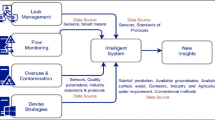Abstract.
Measurements of water pressure beneath Trapridge Glacier, Yukon Territory, Canada show that the basal water system is highly heterogeneous. Three types of behaviour were recorded: pressure records which are strongly correlated, records which are strongly anticorrelated, and records which alternate between strong correlation and strong anticorrelation. We take the pressure in bore-holes that are connected to the evacuation route for basal water as the forcing, and the other pressures as the response to this forcing. Previous work (Murray and Clarke 1995) has shown that these relationships can be modelled using low-order nonlinear differential equations optimized by inversion. However, despite optimizing the model parameters we cannot be sure that the final model forms are themselves optimal. Computational intelligence techniques provide alternative methods for fitting models and are robust to missing or noisy data, applicable to non-smooth models, and attempt to derive optimal model forms as well as optimal model parameters. Four computational intelligence techniques have been used and the results compared with the more conventional mathematical model. These methods were genetic programming, artificial neural networks, fuzzy logic and self-organizing maps. We compare each technique and offer an evaluation of their suitability for modelling the pressure data. The evaluation criteria are threefold: (1) goodness of fit and an ability to predict subsequent data under different surface weather conditions; (2) interpretability, and the extent and significance of any new insights offered into the physics of the glacier; (3) computation time. The results suggest that the suitability of the computational intelligence techniques to model these data increases with the complexity of the system to be modelled.
Similar content being viewed by others
Author information
Authors and Affiliations
Rights and permissions
About this article
Cite this article
Corne, S., Murray, T., Openshaw, S. et al. Using computational intelligence techniques to model subglacial water systems. J Geograph Syst 1, 37–60 (1999). https://doi.org/10.1007/s101090050004
Issue Date:
DOI: https://doi.org/10.1007/s101090050004




